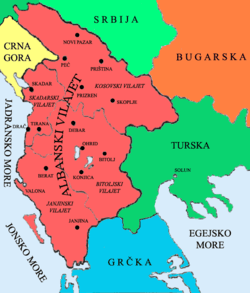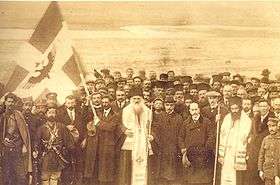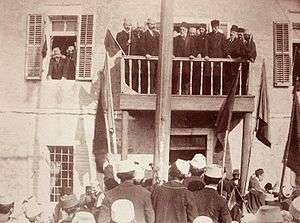Partition of Albania


The Partition of Albania (Albanian: Copëtimi i Shqipërisë) is a term used for the partition of the Albanian state, which proclaimed its independence on 28 November 1912. The delination of the newly established Principality of Albania under the terms of the London Conference of 1912-1913 (29 July 1913) and the Ambassadors of the six Great Powers of that time (Great Britain, France, Germany, Austria-Hungary, Russia and Italy) left Albanian and non-Albanian populations on both sides of the border. Representatives of the Albanian national movement viewed this as partition of claimed Albanian-inhabited territories, also territories contained in a proposed Albanian Vilayet.[1][2][3]
After the establishment of the Albanian state, there were plans to partition Albania during World War I;[4] however, Albania was not partitioned and maintained its independent existence.[5] Additional plans of partition were negotiated during and after World War II.[6]
History
Prelude

The 1877-1878 Russo-Turkish War severely contracted the Ottoman possessions in the Balkan Peninsula, leaving the empire with only a precarious hold on Macedonia and the western Balkans. Albanians had been under Ottoman Empire since 1479 with the fall of Shkodër. The region claimed by Albanian national leader was ethnically heterogeneous, consisting of large areas inhabited also by Bulgarians, Greeks, Serbians, Turks and Aromanians,[7][8] though Sami Frashëri (or Şemseddin Sami) claimed that Albanians were the majority of the population in the four vilayets of İşkodra, Yannina, Monastir and Kosovo.[9] The first postwar treaty, the abortive Treaty of San Stefano signed on 3 March 1878, assigned Albanian-populated lands to Serbia, Montenegro, and Bulgaria. Austria-Hungary and the United Kingdom blocked the arrangement because it awarded Russia a predominant position in the Balkans and thereby upset the European balance of power. A peace conference to settle the dispute was held later in the year in Berlin. The Congress of Berlin ceded to Montenegro the cities of Bar and Podgorica and areas around the mountain villages of Gusinje and Plav, which Albanian leaders considered Albanian territory,and viewed this as a partition of Albanian-inhabited territories.[10] In February 1879, the Powers insisted that the Porte give up the Albanian-claimed areas of Plava, Podgorica, Gucia and Ulcinj, and withdraw all Ottoman troops from the disputed zones.
Congress of Berlin
Albanians view the Congress of Berlin as the partition of some of the Albanian-inhabited territories, which Albanians considered to be part of the Albanian Vilayet. The congress ceded to Montenegro the cities of Bar and Podgorica and areas around the mountain villages of Gusinje and Plav. The Albanians created the League of Prizren to counter the loss of territories where Albanians were a majority, and organized armed resistance efforts in Gusinje and Plav, where the Montenegrin forces were met by fierce resistance. A border tribesman at the time described the frontier as "floating on blood". Seeing the resistance, the Congress decided to give Ulcinj to Montenegro. The League of Prizren was forces to retreat from Ulcinj, after being crushed by the Ottoman army led by Dervish Pasha.[11]
Balkan Wars
On 8 October 1912, Montenegrin troops marched in the vilayet of Shkodra. That was followed by Serbia, Bulgaria, and Greece to declare war on Ottoman Empire, thus starting the First Balkan War. Montenegrin, Serbian and Greek forces advanced in territories which were majorly populated by Albanians, and tried to change the ethnic reality through extermination of the Albanian population, with around 25 000 Albanians killed by early 1913.[12] Alarmed at the plans of Montenegro, Serbia and Greece to partition between them the territories of the western Balkans, the Albanians delegates met at a congress in Vlorë, where on 28 November 1912 declared the independence of Albania.[13]
On 3 December 1912, the ambassadors of the six Great Powers of that time (Great Britain, France, Germany, Austria-Hungary, Russia and Italy) met in London to decide about the fate of the Albanian-inhabited territories. After much discussion, the Ambassadors reached a formal decision on 29 July 1913 to establish the Principality of Albania which independence would be recognized, but more than half of the territory of the Independent Albania and about 30%-40%[14] of the ethnic Albanian population would be awarded to Serbia, Montenegro, and Greece. Though deprived of more than half of its ethnic territory, Albania would be a sovereign state independent of the Ottoman Empire.[15][16]
Delination of the Albanian border
A number of boundary commissions were sent in Albania in order to delinate the borders of the new state, on an ethnographic basis, according to the terms of the London Peace Conferences. However, the commission being unable to delinate the area of southern Albania on such a basis, fell back upon economic, strategic and geographical arguments for the delimitation of the southern border. As a result, most of the disputed area was left to Albania. This decision catalyzed an uprising among the local Greek population, which declared the population of the region that was temporary settled by the Protocol of Corfu.[17]

Plans for further partition of Albania
After the establishment of the Albanian state, in 1912, there were plans to partition Albania during World War I. In 1915, a secret treaty signed in London included the partitioning of the country,[4] As part of this treaty, in 1919 an agreement was signed between Italy and Greece that included plans of annexation of Albania between the two countries.[18] According to this agreement, known as Venizelos–Tittoni agreement, signed on 20 July 1919, Northern Epirus (parts of southern Albania) would be incorporated to Greece, while Greece would recognize an Italian mandate for central Albania.[19]
During World War II, when Albania was under personal union with Italy, there were plans of partition between Yugoslavia and Italy.[6] On the other hand, in 1944, while Albania came under communist control, a resolution of the United States Senate supported the cession of Northern Epirus to Greece.[20]
Aftermath

The borders of Albania established in 1913 left a large number of ethnic Albanians outside the new state, and many of them fled or were forcibly driven inside the recognized borders of Albania.[21] In Kosovo, the Serbian troops tried to change the demography through mass expulsions. Over 100 000 Albanians emigrated from Kosovo during 1918-1941[22][23]
See also
- League of Prizren
- History of Albania
- Albanian Declaration of Independence
- Albanian nationalism
- Albania during the Balkan Wars
References
- ↑ Merrill, Christopher (1999). Only the Nails Remain: Scenes from the Balkan Wars. Rowman & Littlefield. p. 230. ISBN 9780742516861.
- ↑ Magocsi, Paul R.; Multicultural History Society of Ontario (1999). Encyclopedia of Canada's peoples. University of Toronto Press. p. 180. ISBN 9780802029386. Retrieved 1 February 2012.
- ↑ Schwandner-Sievers, Stephanie; Bernd Jürgen Fischer (2002). Albanian identities: myth and history. Indiana University Press. p. 44. ISBN 9780253341891.
..events of 1913 when a major part of the Albanian-inhabited territories was partitioned among neighbouring Balkan states.
- 1 2 Staar, Richard F. (1984). Communist regimes in Eastern Europe (4. ed., 3. print. ed.). Stanford, Calif.: Hoover Inst. Press, Stanford Univ. p. 3. ISBN 978-0-8179-7692-7.
- ↑ "U.S.-ALBANIAN RELATIONS AND ALBANIA'S PROGRESS TOWARD EU AND NATO" (PDF). CENTER FOR STRATEGIC AND INTERNATIONAL STUDIES. Retrieved 4 February 2012.
- 1 2 Fischer, Bernd J. (1999). Albania at war : 1939-1945. London: Hurst. p. 15. ISBN 978-1-85065-531-2.
- ↑ Pavlowitch, Stevan K. (1999). A history of the Balkans, 1804 - 1945. London [u.a.]: Longman. p. 146. ISBN 978-0-582-04584-2.
- ↑ Király, Béla K. (1985). Gale Stokes, ed. Insurrections, wars, and the Eastern crisis in the 1870s. Boulder: Social Science Monographs. p. 148. ISBN 978-0-88033-090-9.
- ↑ Gawrych, George Walter (2006). The crescent and the eagle: Ottoman rule, Islam and the Albanians, 1874-1913. I.B.Tauris. pp. 99–101. ISBN 9781845112875.
Albanians comprised a majority in all four provionces
- ↑ Miranda Vickers (1999). The Albanians: a modern history. I.B.Tauris. p. 35. ISBN 978-1-86064-541-9. Retrieved 1 February 2012.
- ↑ Warrander, Gail (2011). Kosovo. Bradt Travel Guides. p. 14. ISBN 9781841623313.
- ↑ Levene, Mark (2013). Devastation: Volume I: The European Rimlands 1912-1938. Oxford University Press. p. 106. ISBN 9780199683031. Retrieved 23 December 2013.
- ↑ "Albania: History". Encyclopedia Britannica. Retrieved 31 January 2012.
- ↑ Elsie, Robert (2010), "Independent Albania (1912—1944)", Historical dictionary of Albania, Lanham: Scarecrow Press, p. lix, ISBN 978-0-8108-7380-3, OCLC 454375231, retrieved 4 February 2012,
... about 30 percent of the Albanian population were excluded from the new state/about 40% ... found themselves excluded from this new country p.243
- ↑ Elsie, Robert. "The Conference of London". Retrieved 5 January 2012.
- ↑ Vickers, Miranda (1999). The Albanians: a modern history. I.B.Tauris. pp. 70–80. ISBN 9781860645419.
- ↑ Draper, Stark. "The conceptualization of an Albanian nation" (PDF). Ethnic and Racial Studies. Volume 20, Number 1. Retrieved 2 February 2012.
- ↑ (ed.), Stephanie Schwandner-Sievers ... (2002). Albanian identities : myth and history (1. publ. ed.). London: Hurst. p. 135. ISBN 978-1-85065-572-5.
- ↑ Burgwyn, H. James (1997). Italian foreign policy in the interwar period : 1918 - 1940 (1. publ. ed.). Westport, Conn. [u.a.]: Praeger. p. 15. ISBN 978-0-275-94877-1.
- ↑ RFE/RL research report. Volume 2. weekly analyses from the RFE/RL. 1993. p. 31.
- ↑ McCarthy, Justin (2002). Population history of the Middle East and the Balkans. Isis Press. p. 44. ISBN 9789754282276.
- ↑ https://books.google.com/books?id=M_0-QfRL8eMC&pg=PA310&lpg=PA310&dq=albanians+fleeing+to+albanian+after+1913&source=bl&ots=eBmYfz7gm_&sig=0ukYlglQB890zT13xCgfATO5-mg&hl=en&sa=X&ved=0CDoQ6AEwBmoVChMIzqT755zhyAIVijsaCh0BOwZn#v=onepage&q=albanians%20fleeing%20to%20albanian%20after%201913&f=false
- ↑ Bugajski, Janusz (2002). Political parties of Eastern Europe: a guide to politics in the post-Communist era. 448: M.E. Sharpe. ISBN 9781563246760.
- Further reading
- Books about Albania and the Albanian people (scribd.com) Reference of books (and some journal articles) about Albania and the Albanian people; their history, language, origin, culture, literature, etc. Public domain books, fully accessible online.
External links
| Wikimedia Commons has media related to History of Albania. |
